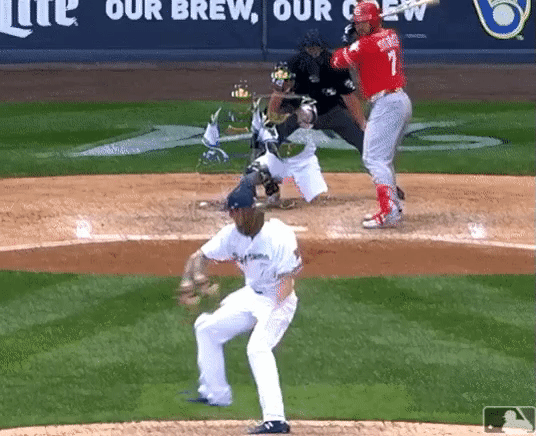Does Josh Hader have another gear? How should I feel about Kenta Maeda's arrival?
Bang the trash cans! The first edition of Rich People Conversations is here!
Welcome to Rich People Conversations, the world’s only newsletter about both the Milwaukee Brewers and Minnesota Twins. Team workouts have begun. Let’s get wild.
I’m Curt Hogg and will be joined by my co-authors Tom Dierberger and Jake Schultz as we appreciate Carlos Gomez, dive into the teams we watch far too much of and mix in some baseball oddities.
You can subscribe below! We’ll publish new issues every week during spring training and on a more regular basis once the season begins. You’ll notice this post is a little long. That won’t usually be the case; chalk it up to 3.5 months sans baseball, I guess.
Before we get started, here’s the shameless plug to follow us on Twitter that you should’ve seen coming: @CyrtHogg, @tomdierberger and @StJake29.
I have some thoughts about Josh Hader
-Curt
The most important pitch in baseball is Josh Hader’s fastball.
The short version of why this is the case: Hader throws it more than 80 percent of the time. It’s one of the best pitches in the sport, but it has a history that, when it gets hit, it gets hit. Hader also appears in as many high-leverage situations as any pitcher in baseball. Whether the Brewers win or lose on any given night often comes down to the success of that singular pitch.
Hader’s four-seamer has perhaps been the sport’s most dominant pitch the last two seasons. In 2019, Fangraphs measured it just a tick below Max Scherzer’s heater in terms of full-season run value despite Hader throwing nearly 100 fewer innings. It generated a greater percentage of whiffs than any other fastball last year, with hitters missing on 41 percent of swings. It once made Daniel Murphy, an abject fastball punisher who hit .328 and slugged .583 against four-seamers from 2015-2018, do this on consecutive swings during Game 163 in 2018.
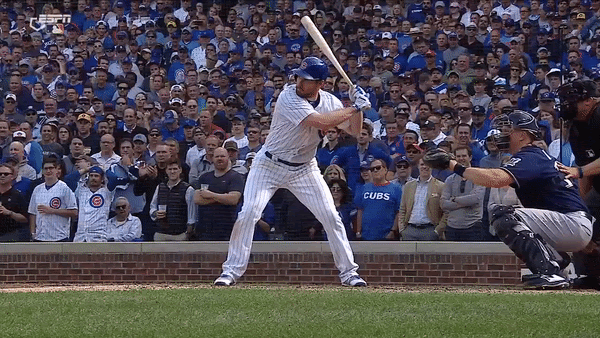
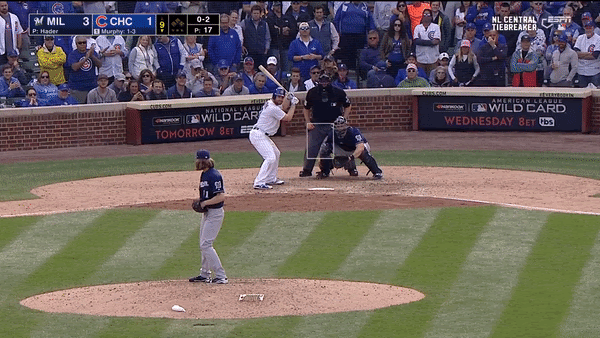
lol.
With the fastball doing most of the heavy lifting, Hader has accumulated 5.3 WARP the last two years. That’s pretty good!
But... should he throw his dagger less?
That would mean Hader would be throwing the only other pitch really left in his repertoire, his slider.
Hader threw the offering just 15.6 percent of the time last year per Brooks Baseball, down from 20.6 percent in 2018. Its readings don’t jump off the page at you. The velocity (which, to be fair, doesn’t particularly correlate to swinging strikes for sliders) is nothing special at a 82.2 mph average. It’s kind of a sidespin slider, similar in many ways to Rick Porcello’s offering. Statcast says it has below-average break both horizontally and vertically.
The actual production of Hader’s slider, though, is undeniably outstanding.
Since debuting in 2017, Hader has allowed opponents to hit just .107 against the pitch. It’s been a very nice option for the southpaw, striking out 69 hitters in that time, which is 23 percent as many Ks as he has with his fastball despite throwing it just 20.4 percent as much as the cheddar.
Of Hader’s 563 sliders tracked by Brooks Baseball over three years, only three have gone for extra bases and just one has left the yard (yep, you recall the ill-timed hanger to Cody Bellinger on Easter last spring that took away Eric Thames’ 2034 Rob Deer-esque bobblehead giveaway). Over the final two months of the 2019 season, only one went for a hit: a dribbler to shortstop that the speedy Tim Locastro beat out for an infield single.
Hitters have an average exit velocity of 84.7 mph over the last two years against the slider, which would rank 58th out of 267 pitchers with at least 50 ball-in-play results in that time (Hader has only had 45 such results).
So, how exactly has Hader’s slider been so successful without eye-popping metrics behind the pitch?
To start, that’s often the nature of sliders; they can be confusing.
No pitch has more variance from one player to the next. Patrick Corbin’s slider, for example, looks different than Adam Ottavino’s Sweeper of Disaster that would strike out Babe Ruth (but isn’t, apparently, good enough to throw on an 0-2 count after three straight fastballs to Mike Moustakas with the game on the line in the playoffs heyoo), yet you could easily argue for Corbin’s slider as being the best in the game despite not having the sexiest of numbers behind it.
So we may be able to point to a few reasons why Hader’s slider has produced how it has, even if we can’t provide one clear, concise answer. (Look at that! You sign up for a nifty, fresh newsletter and the first thing you get is a bunch of “well, I have no idea!” Fun!)
At some point while poring over the data for Hader, I remembered a quote from Twins legend Liam Hendriks from a really good piece on sliders by Eno Sarris at The Athletic. It’s not exactly a “new” concept, but it sums things up pretty well.
“If you look around the league, the best breakers are not the early breaking pitches, they look exactly the same and then they split.”
I think that’s definitely at play with the Brewers relief ace.
Hader’s pitches look very similar at the batter’s decision point compared to average. He has three pitch pairings in the top 14 percent of Baseball Prospectus’ pre-tunnel max distance, which measures the distance between consecutive pitches in a pitch pairing at the hitter’s decision-making point. His average pre-max distance across his pitch pairings was 70th out of 496 pitchers last year.
That’s all a really fancy way of saying, “an at-bat against Josh Hader sucks.” It’s something that could be inferred by watching him pitch.
A basic eye test will tell you that, holy crap, Hader’s fastball is incredibly difficult to pick up with its arm slot, how he hides the ball and also because of all those long limbs flailing at you. Hitters know exactly what’s coming and still strike out nearly half the time.
Add in the fact that he doesn’t have a natural high-spin riser or elite velocity and still has gotten more whiffs than any pitcher, and, yeah, you’ve got to think that picking up Hader’s fastball is a terrible, horrible, no good, very bad time.
Picking up Hader’s slider, then, would be a similar challenge, even if he does tend to drop his arm down a bit more than when throwing a fastball.
You can almost sense the helplessness of these hitters below, geared up for Hader’s fastball only to have no answer when the slider comes spinning in. It plays up incredibly well with the heater.

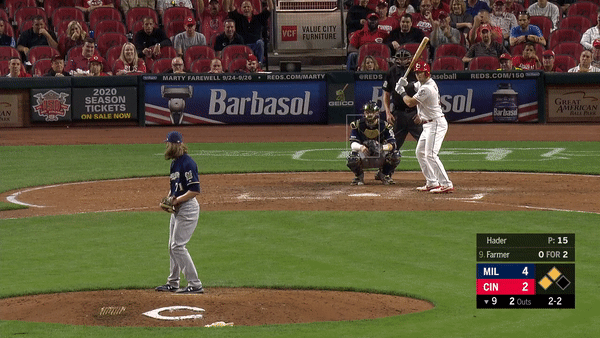
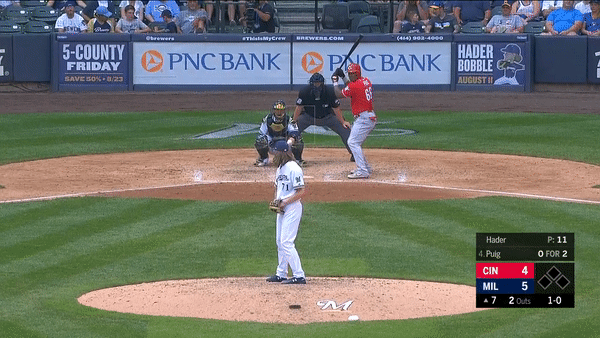
Hader’s fastball, of course, is still his best pitch and its existence is one of the primary factors in the slider’s miniscule batting average against. Hader himself has practically said as much.
“You know they’re hunting the fastball. That’s my bread and butter, the No. 1 pitch I’ve always used. As a hitter, you’ve got to ‘sit’ one pitch. I don’t think you can ‘sit’ both pitches and protect (the plate).”
But when hitters have squared up Hader, it has almost exclusively been against the heater.
Hitters rarely made contact against Hader, but when they did, they feasted. Hader gave up 14 home runs off his four-seamer in 2019, tied for 25th-most in baseball. Six other pitchers, all starters, also tied that total. That group averaged 2,672 four-seamers thrown on the season. Hader, as you know, is a reliever. He threw 1,181 fastballs. One out of every 8.7 balls put into play left the yard.
Those are not the numbers you want to hear if you are one Joshua Ronald Hader.
Even with homer and exit velocity numbers that should make you want to send the kids to bed, there’s still an argument to be made for Hader continuing with his 2019 pitch selection. Most people would still take a season in which they were so good they won the National League reliever of the year award even while battling an awful (and fluky-high) HR/FB rate. The status quo, after all, has been working. Maybe the ball not being made of dragless cowhide and bottle rockets will help.
But perhaps Hader doesn’t need to be as reliant on a pitch that was smashed for 14 homers and an exorbitant exit velocity when he’s got another offering that pairs well with it and has a track record of baffling hitters. A greater pitch mix and some timely homer regression could be a solid pairing for Hader in his fourth major league season.
The Dodgers/Twins/Red Sox trade, oh, that whirlwind of a deal
-Jake
Curt, Tom and I decided to do this newsletter a couple of months ago, and we’ve since bounced ideas around on what to write for the first edition. We could rank Twins relievers! We could figure out which Twins player represented each Oscar movie (Mitch Garver was like Parasite where it’s like “Oh, this is go--OH MY GOD”). I was even thinking I might get frisky and write about Jake “Eggs” Odorizzi signing a qualifying offer. Riveting stuff in Twins land!
Then the Twins did the unthinkable and signed an upper-echelon free agent (with straight cash, homie). They won a bidding war where they’ll pay a non-Joe Mauer up to nine figures. Well, obviously that will lead the opening newsletter, right?
Nope.
Three weeks or three generations later, I don’t know which at this point, the Boston Red Sox and Los Angeles Dodgers decided to make a little deal. You know the deal I’m talking about, and if you don’t, I’m sorry to say you may be reading the wrong newsletter. The Red Sox opted to ship all-world OF Mookie Betts and former Cy Young winner David Price to the Dodgers, in what I can only imagine is penance for cheating in the 2018 World Series, for Alex Verdugo and, well, that’s where it gets complicated.
This newsletter is notably not about the Dodgers or the Red Sox, so I’m off to a great start in edition numero uno. The reason to talk about all of this is because Minnesota did another non-Twinsy thing: the Twins traded an elite prospect for a veteran.
Now, I can already see the responses flooding my mailbox saying, “Hey, moron, what about that time the Twins traded Wilson Ramos for Matt Capps?”
To which I say: “That’s true, Mom, but, see, this is different.”
When Minnesota traded Ramos for Capps in 2010, it was simple: then-Twins general manager Bill Smith called up the Washington Nationals, asked if they wanted the Twins’ best prospect for an average closer, and made the swap.
This time around, the Twins were involved in a Chicago Fire-level drama, with equally bad actors and an ultimately confusing plot line that made you wonder if it was all worth it at the very end.
In the end, the Twins shipped prospect pitcher/flamethrower Brusdar Graterol to the Dodgers for RHP Kenta Maeda, with some other details going both ways. This was a complicated week emotionally, mentally and physically--though, I probably ought to get that last part checked out. Anywho, let’s revisit that roller coaster.
‘Wait, what?’
I don’t remember where I was or what I was doing when I heard that Betts was going to be traded AND the Twins were involved, but I’m reasonably sure that I blacked out. I read the tweet, fell over, refreshed Twitter 8,000,000,000 times, read it again and my brain short-circuited like a hot plate at my first apartment. Mookie actually being traded seemed fake to me, and the Twins actually helping facilitate this seemed so not like the Twins that I grew up with.
‘This is not good.’
And I’ll be honest, I didn’t like it at first. At the time, the Twins were shipping Graterol, a 21-year-old pitcher with a rocket launcher strapped to his shoulder who has been around the No. 2 prospect in their system, for a 31-year-old Maeda who is notably lacking a rocket launcher shoulder. Maeda is a good pitcher, but Graterol can reach back and touch triple digits. More than the numbers, though, he represents something the Twins haven’t had much of in my lifetime: a prospect who throws the bejesus out of the ball. He’s a pitcher where you can hear the fastball. And the guy is a thicc boi. You can’t quantify that. (Yes, you can: 6-foot-1, 265 pounds)
‘OK, Kenta is good’
But I’m no dumby. I have a free membership to FanGraphs and frequent Baseball Savant. Kenta Maeda is a good pitcher, folks. He doesn’t inspire awe the way elite pitchers do, but he’s a valuable arm who, despite a low-90s fastball, strikes out 26.7 percent of batters and sports a career 3.87 ERA and 3.71 FIP. Among Twins starters, only Odorizzi has struck out nine or more batters per nine since Maeda debuted in 2016 (9.46 K/9).

Yep, that’ll do.
And his contract is an absolute steal. He’ll make $3 million each of the next four years, with the possibility to make up to $8-10 million, based on incentives. Even if he pitches out of his mind, he’ll still make, annually, around half what Odorizzi makes this season.
Throw in the fact that there are some question marks with any pitching prospect, especially one listed at 265 pounds (again, thicc boi), with a history of arm issues and high probability of pitching his way into the bullpen, and the trade starts to make some sense.
The Twins needed more arms that could start who didn’t have the last name Smeltzer or Dobnak (I love those guys, but also, lol).
‘Wait, what?’ Part 2
Did the Red Sox really just bail on the deal because, after looking at Graterol’s medical reports, they don’t think he’ll be a starter? Oh, you mean like Dan Hayes and Aaron Gleeman reported weeks ago? And people have been talking about for months? Come on, I just talked myself into this!
Ken Rosenthal later tweeted that some of the people involved in the deal believed the Red Sox were using the medical report as a chance to back out of a deal that was widely lambasted. Boston had to know Graterol wasn’t exactly a lock for the rotation when they initially agreed to the trade, right?
The truth is, though, that no trade would be deemed good enough for Betts, unless Boston was walking away with Gavin Lux, Dustin May, Jeter Downs and another piece, which was never going to happen. Again, Rosenthal tweeting right from my heart.
‘Please, no.’
OK, so the Twins stick with Graterol. Fine! He’s a good prospect who will help the bullpen now! Wait, the Twins need to add to the trade? Why add even more when already giving up your No. 2 prospect for a good-not-great starter? Get out of here with that noise.
‘Is it for real this time?’
Finally, the dust settled. Betts and Price go to the Dodgers, along with $42 million. Downs, Verdugo and Connor Wong head to the Sox. Graterol goes to the Dodgers, along with outfield prospect Luke Raley and Twins’ Competitive Balance pick (67th pick in the 2020 draft). The Twins get Maeda, catching prospect Jair Camargo and $10 million, which will likely pay Miguel Sano’s tab at Taco Bell.
It didn’t feel real. It still doesn’t. Until I see Maeda throwing in a Twins jersey in a real game, I’m not sure I fully believe it. Ultimately, the Twins get a guy who jumps right into the second or third spot in the rotation and will likely be a go-to guy in the postseason, if and when they get there (*knocks on wood so loudly all of Brooklyn Park, Minn., can hear it*).
It all comes in exchange for a prospect who has a ceiling that’s so fun to dream about, but I’ll admit I think likely ends up being a volatile late-inning guy. On the Dodgers, Graterol turning into a star feels inevitable but maybe that’s OK. The Twins rotation looks a lot more like their starting lineup now; there aren’t a ton of stars there but they sure have plenty of depth.
Catching up
Twins
We’ve covered the Twins’ biggest news of the off-season at length, so here are a few bullet points to refresh your baseball mind as spring training begins …
Long before any Donaldson or Maeda news there were a few moves that will contribute in a big way for the Twins in 2020. Sergio Romo was re-signed to a one-year deal after joining the club at last year’s trade deadline. On the same day, Minnesota also signed veteran reliever Tyler Clippard, adding a right-hander who’s logged a 10.4 K/9 over the past four seasons. Clippard and Romo will complement the Twins’ rising bullpen trio in Trevor May, Tyler Duffey and Taylor Rogers.
Rich Hill and Homer Bailey were signed to take pressure off of youngsters like Randy Dobnak, Lewis Thorpe and Devin Smeltzer in the starting rotation. Hill won’t be able to pitch until June due to his rehab from elbow surgery, but the Twins have to feel much better about their rotation suddenly bursting with veterans in Maeda, Bailey and Hill.
A surprise of the off-season was the Twins re-signing Michael Pineda, who was the team’s best starter in July and August before he was busted for performance-enhancing drugs and forced to sit out the remainder of the season. Pineda still has 39 games to serve on the 60-game suspension but can join the team in May.
Taking the place of backup catcher Jason Castro (now with the Los Angeles Angels) is Alex Avila, who is more than familiar with the AL Central having played for Detroit and Chicago from 2009-16. Avila has the career stat line of, well, a backup backstop -- a .235/.348/.412 slash line and likely won’t do much to quiet the Willians Astudillo stans (myself included).
Miguel Sano earned himself a juicy three-year deal worth $30 million (with a club option for $14 million in 2023). He is also reportedly in The Best Shape of His Life ™ for the fourth straight spring training.
Justin Morneau, the 2006 American League MVP who smacked the fourth-most home runs in franchise history (221), will be inducted into the Twins Hall of Fame on May 23.
Most importantly, the Twins’ Single-A affiliate changed its name from the Fort Myers Miracle to the Fort Myers Mighty Mussels. As a self-proclaimed connoisseur of unique team logos and names, I couldn’t mash the “purchase” button fast enough on a t-shirt. I mean, c’mon. Art.


From the last week for the Brewers
Ron Roenicke is managing the Red Sox! I could comment on Roenicke sticking with *Chris Narveson* trailing 5-4 in the third inning of an elimination game but my therapist would appreciate it if we didn’t need to go there today.
Corbin Burnes isn’t wearing his goggles after getting Lasik and I quite literally do not recognize him. This is the important stuff, folks.
Josh Hader lost his arbitration case. Brent Suter avoided his by inking a two-year extension. Eat at Arby’s.
Freddy Peralta is adding a slider?!?
The Brewers are bringing back the Wisconsin residents-only presale for Cubs games. I’m not really sure this works, nor is it a huge deal, but we all know it will be plenty talked about.
Ranking the new threads
Here are our definitive rankings of the Brewers’ four new uniforms.
Curt
Road Navy
I’d like to first note that I think I’m the only person alive who actually liked the old Brewers uniforms with the barley ‘M’ logo. As for the current road navy, let’s see: the best of the new scripts on the front, the best of the new logos on the left sleeve, the best color combo and the yellow trim on the front panel. Someone hold me. Please. Anyone.
Home Cream
There’s a non-zero chance I picked this one second because it was the one Christian Yelich was featured wearing when the first promotional material came out for the new uniforms.
Home Pinstripe
These are still fine! I’m not sure how I feel about the wheat ball logo yet. I think I don’t like it? The classic Brewers pinstripe jerseys (along with the blue ball-and-glove hat) were just incredible, though, and the new version of those just can’t match that look.
Road Gray
The addition of the brick logo on the sleeve (and the trim on the bottom of the sleeve) is what redeems these. Just give me the navies on the road.
Tom
Home Cream
I’d like to take a moment to celebrate the fact that Milwaukee disposed of the hideous ‘M’ wheat script that plagued Miller Park for two decades. All four of these jerseys are an improvement on the bland home blues and whites and road grays from 2000-19. That being said, the shiny new home creams stand above the others. The clean cream color combined with the sharp yellow trim is just … *chef’s kiss*. It’s a tribute to Cream City without needing to put those words on the chest (cough cough, atBucks).
Road Navy
I didn’t like these at first glance. But the more I look at that picture of everyone’s favorite nerd Brent Suter (apologies to Mr. Sogard), the more I like ‘em. The jerseys are perfect. The only thing I would change is the hat, which looks too much like an afternoon at Maryvale to be worn in the regular season. If the Brewers wanted to spice up their lid, I’d slap the Barrelman logo on there instead.
Home Pinstripe
Previously my favorite Brewers uniform, I do miss the throwback color scheme. The darker blue just doesn’t feel quite right. But will I enjoy watching Yelich mash in pinstripes this summer? Yes, yes I will.
Road Gray
The road grays are really a carbon copy of every generic road baseball uniform ever created. But there are 162 games and only a certain amount of laundry quarters to go around, so these will do. These will do just fine.
Jake
Home Cream
Since I met Curt, I’ve been shouting about how the Brewers need to ditch the champagne gold and lean into the blue-and-yellow. This was even better than I imagined. It’s beautifully simple, with truly memorable details like the color on the sleeve. It helps that Ryan Braun, an objectively good looking human, modeled this one, but it’s near perfect. (Curt’s note: Remetee, anyone?) The switch to one of the all-time greatest sports logos helps a lot, too.
Home Pinstripe
Pinstripes feel classic, if also overdone. As a Twins fan, this reminds me of the pinstriped uniforms I grew up with and need back in my life immediately. I agree with Tom, the darker blue feels slightly off here, but it’s a solid all-around uniform.
Road Gray
For as memorable as the home cream uniform is, the gray is equally forgettable. I like the Wisconsin patch and like the fact that this, like the higher-ranked uniforms, feels classic. I won’t fawn over these, but they get the job done. I respect that the Brewers didn’t veer down the baby blue path like everyone else (he says as the proud owner of a baby blue Byron Buxton jersey).
Road Navy
This is where Brewers fans will hate me. I really want to like this and there is a lot to like! The navy and yellow are a great combo and the script is strong. I just can’t get over the hat. Maybe with a different hat I could get on board, but right now it makes me think of somebody running an American Legion team. I’d also throw out the piping on the chest and down the pant le--OK, stop chucking tomatoes at me, people.


